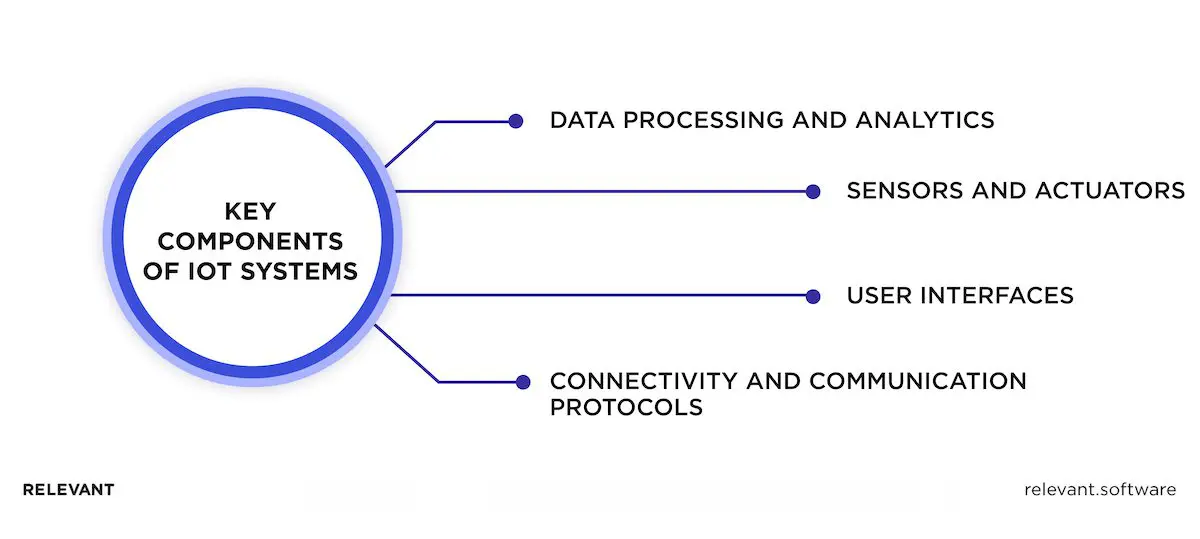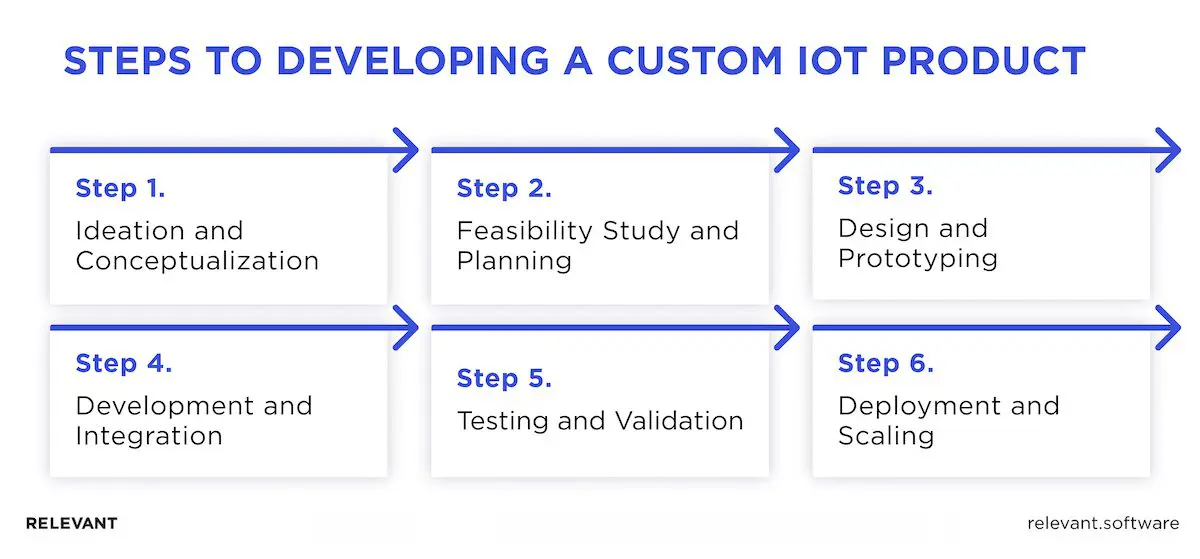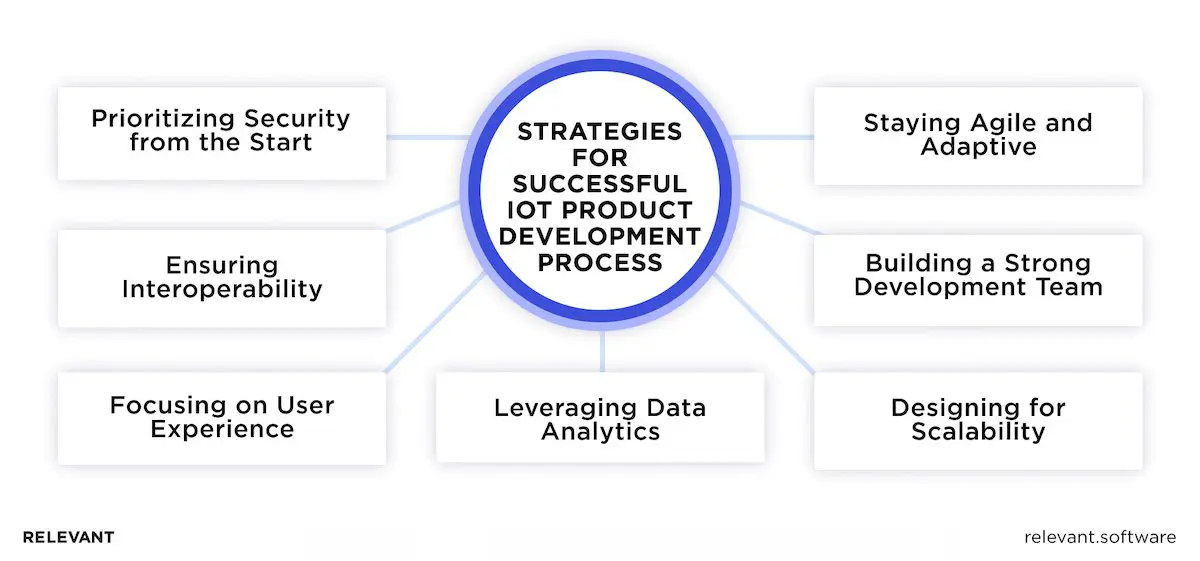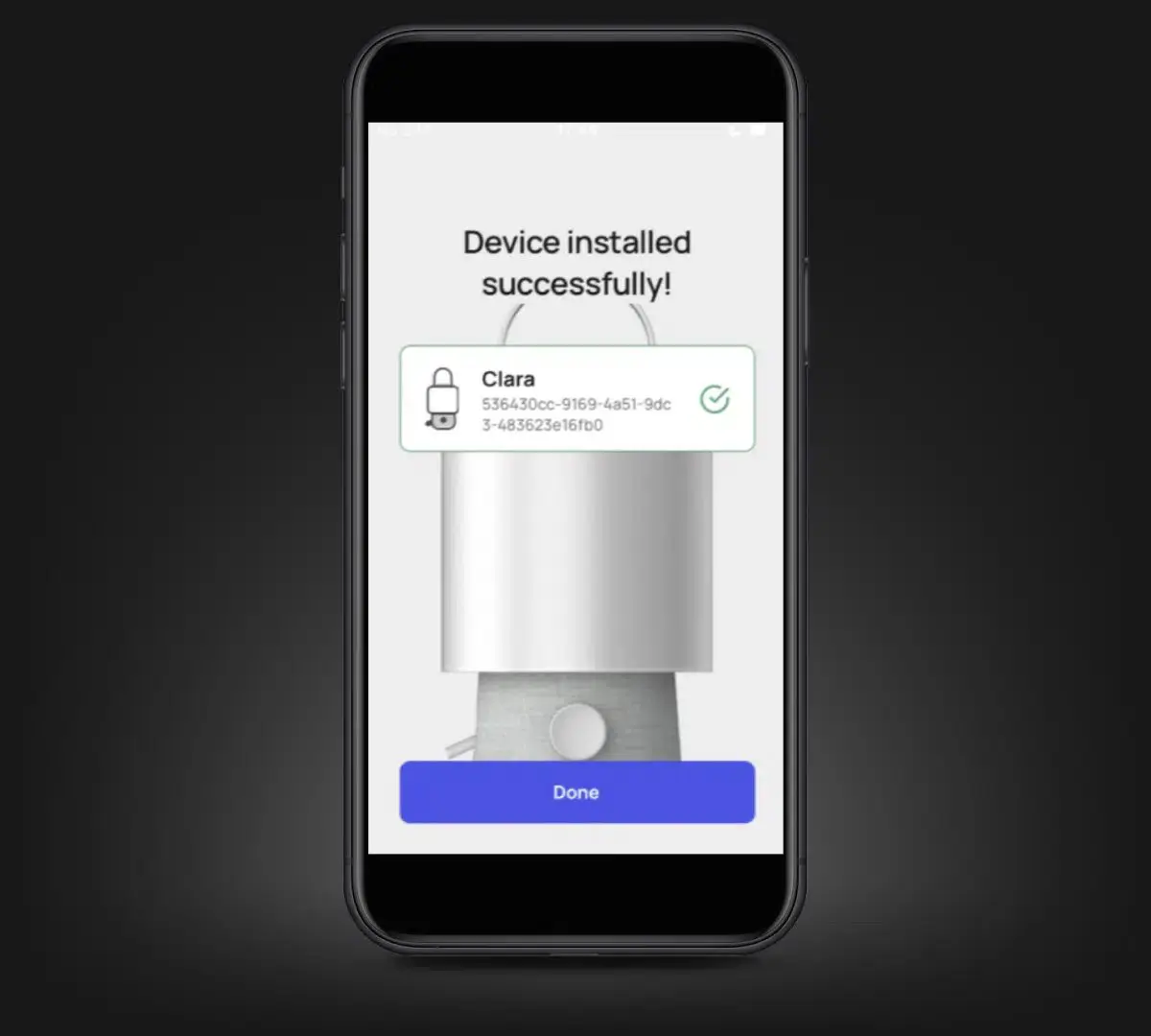Steps and Strategies for Effective IoT Product Development

You have a groundbreaking IoT product idea, and the excitement of its potential impact on everyday life is electrifying. But soon, the hard reality of development hits. Choosing the right sensors and communication protocols and securing data – the complexity of IoT product development can easily overwhelm even seasoned professionals.
Remain steadfast, visionary innovator. With our in detail guide on IoT product development stages, you can tackle the usual project headaches without breaking a sweat. From hardware and software design to testing and deployment, we’ve covered you with practical strategies and expert insights.
What is the Internet of Things (IoT)?
IoT refers to the interconnected network of physical objects—anything from smart home gadgets and fitness wearables to industrial machinery and livestock—equipped with sensors, software, and technologies. These intelligent devices collect and exchange data online, enabling communication among themselves and with users.
Key Components of IoT Systems
Effective custom IoT product development is built on a solid comprehension of its core elements. Let’s examine these foundational components:

Sensors and Actuators
Integral to IoT systems, sensors gather and transmit environmental data (like temperature, humidity, motion, and pressure) to provide real-time insights. Actuators use the received data to perform actions, such as tweaking a thermostat or initiating an alarm system.
Connectivity and Communication Protocols
IoT devices need strong connectivity to talk to each other and centralized systems. Wi-Fi, Bluetooth, Zigbee, and cellular networks are among the communication protocols that ensure efficient data transmission. Selecting the appropriate protocol depends on range, power consumption, and data rate requirements.
Data Processing and Analytics
To gain valuable insights, the data from IoT devices must be processed and analyzed. This process involves edge computing, which handles data close to its source, and cloud computing, which sends data to centralized servers for thorough analysis. Advanced analytics and machine learning algorithms detect patterns and trends, facilitating predictive maintenance and informed decision-making through the use of big data.
User Interfaces
With user interfaces (UIs), users can interact with Internet of Things systems, observe performance metrics, and control devices. Effective UI design allows users to access and interpret data easily, configure settings, and receive alerts. This device management can range from mobile apps and web dashboards to voice-controlled assistants and wearable devices.
More about What is IoT
Why IoT Product Development is Critical
If you’re aiming for growth and innovation, ignoring IoT product development isn’t an option. The projection of 75 billion connected devices by 2025 highlights the immense potential within the IoT market. To enhance clarity, we have organized the benefits into a table.
| Why IoT Product Development Matters | What This Means for Your Business |
| Optimize Processes | IoT can streamline your processes, cut down on costs, and enhance overall efficiency, leading to smoother business functions. |
| Discover New Revenue Streams | With the data from smart devices, you can create innovative services that address new customer needs, leading to fresh revenue sources. |
| Enhance Customer Experience | Smart IoT devices that anticipate and cater to customer needs can dramatically improve user satisfaction and loyalty. |
| Gain a Competitive Edge | Early Internet of Things adoption positions your business as a leader in innovation, setting you apart from the competition. |
| Future-Proof Your Business | With technology constantly evolving, integrating IoT into your operations ensures you can adapt to future advancements. |
| Leverage Data-Driven Insights | IoT platform offers rich data analytics that provides insights for better decision-making, process optimization, and product innovation. |
| Ensure Regulatory Compliance and Safety | IoT systems provide the necessary data precision and timeliness to help you adhere to regulatory standards. |
Steps for Effective Custom IoT Product Development
Turning your IoT idea into a successful product involves several key stages. Each step of IoT product design and development, from the initial concept to market launch, requires strategic planning and execution.

Step 1: Ideation and Conceptualization
The custom IoT product development process begins with a clear vision. This phase is vital for establishing your project’s course.
1.1 Identifying the Problem and Defining Objectives
The initial phase of IoT technology and product development is ideation and conceptualization. Here, you pinpoint the problem you want to address or the opportunity you wish to seize. Also you define the objectives of your product and what value it will provide. This will help differentiate it from existing solutions and establish a foundation for a precise and efficient development process using the IoT architecture and IoT technology stack.
1.2 Market Research and User Needs Assessment
Execute thorough market research to understand the competitive landscape, gauge the market size, and identify new trends. Engage with prospective users to understand their requirements, pain points, and preferences. This customer-centric IoT products strategy ensures your product solves actual problems and satisfies market needs.
1.3 Conceptualizing the Product Idea
With a clear problem statement and market insights, start conceptualizing your IoT product proof of concept. Outline its core features, functionalities, and unique value propositions. Consider how your product will integrate into users’ lives or businesses. Create detailed sketches and diagrams to visualize the product concept.
Step 2: Feasibility Study and Planning
Before initiating development, you’ll need to determine the feasibility of your IoT product. This stage ensures that your idea is viable and sets a realistic roadmap for the project.
2.1 Technical Feasibility Analysis
Examine the technical viability of your IoT product concept. Assess the availability and maturity of the required technologies, including sensors, connectivity options, and data processing capabilities. Determine whether existing infrastructure can support your product or if new developments are necessary.
2.2 Cost Estimation and Budgeting
Estimate the costs for developing your IoT product, covering hardware components, software development, testing, and deployment expenses. Prepare a detailed budget that includes both initial development and ongoing maintenance. Use these estimates to secure the necessary funding.
2.3 Project Planning and Timelines
Develop an all-encompassing project plan that details significant milestones, outputs, and timelines. Identify all required resources, including personnel, machinery, and tools, to ensure the project proceeds smoothly.
Step 3: Design and Prototyping
The subsequent step is to transform your IoT idea into a tangible product via design and prototyping. This stage is crucial for turning theoretical ideas into practical, workable models, particularly in IoT product development, hardware design, and firmware development.
3.1 Hardware and Software Design
Design the hardware components, such as sensors, actuators, and electronic components, that will form the backbone of your IoT product. Simultaneously, plan the software architecture, including firmware, user interfaces, and data processing algorithms. Verify that both hardware and software designs are compatible and integrate smoothly. This is vital for smart home devices, industrial IoT, and other use cases.
3.2 Creating Prototypes and Iterative Testing
Develop initial prototypes to test your product’s core functionalities. Refine prototypes through iterative testing, gathering feedback, and implementing improvements in each cycle. Utilize tools like Raspberry Pi for prototyping and focus on specific use cases.
3.3 User Experience (UX) Design
Design a user-friendly interface that ensures easy interaction with your IoT product. Emphasize creating an intuitive and engaging user experience. Conduct usability tests to ensure the product meets user expectations and provides a seamless experience. A well-designed UX is essential for mass production and market success, particularly in sectors like smart homes and industrial Internet of Things (IIoT).
Step 4: Development and Integration
Once the design and prototypes have been validated, it’s time to move into full-scale development and integration. This phase focuses on building the actual components and ensuring they work together seamlessly.
4.1 Hardware Development
Proceed with the full-scale development of the hardware components. This includes manufacturing sensors, actuators, and other physical elements. Ensure that the hardware is robust, reliable, and capable of performing under various conditions. Mechanical engineering and electronic component design play significant roles here, supporting the manufacturing process and ensuring quality.
4.2 Software Development and Integration
Develop the software components for device firmware, mobile apps, and cloud-based services. Integrate these components to ensure they work harmoniously. Pay attention to security measures to protect data and prevent unauthorized access in hardware design. Overcoming product development challenges at this stage ensures your IoT hardware is secure and efficient, ready for various applications, from heart rate monitoring to inventory management.
4.3 Cloud and Backend Infrastructure Setup
Set up the cloud infrastructure necessary for data storage, processing, and analytics. Select a dependable cloud service provider known for offering scalability and strong security features. Implement backend systems to manage device communication, data ingestion, and user interactions.
Step 5: Testing and Validation
Before launching your IoT product, rigorous testing and validation are essential to ensure it meets all performance and reliability standards. This step helps identify and address any issues before the product reaches the market.
5.1 Functional and Performance Testing
Conduct comprehensive testing to ensure that all features of your IoT product work as intended. Perform performance testing to evaluate the product’s responsiveness, reliability, and efficiency under different conditions and loads.
5.2 Security Testing
Security is paramount in IoT product engineering due to the sensitivity of data and potential risks. Conduct thorough security testing to identify and address vulnerabilities. Implement robust encryption, authentication, and authorization mechanisms to protect user data.
5.3 User Acceptance Testing (UAT)
Include real users in the testing phase to confirm the product meets their needs and expectations. User acceptance testing highlights usability challenges and provides essential feedback for refinement.
Step 6: Deployment and Scaling
The final phase of the IoT product development life cycle involves launching your product and preparing it to handle growth. This stage ensures that your product is ready for real-world use and can efficiently scale as demand increases.
6.1 Preparing for Deployment
Before launching your IoT product, ensure that all systems are thoroughly tested and validated. Prepare comprehensive documentation, including user manuals, installation guides, and troubleshooting resources. Train your support team to handle customer inquiries and issues.
6.2 Scaling the Infrastructure
As your user base grows, ensure that your infrastructure can scale to accommodate increased demand. Implement scalable cloud solutions and load-balancing techniques to maintain performance and reliability.
6.3 Monitoring and Maintenance
Once deployed, continuously monitor your IoT product to ensure it performs optimally. Gather and evaluate data to pinpoint potential problems and areas needing improvement. Regular maintenance and updates are essential for fixing bugs, boosting security, and adding new features.
By following these steps, you can navigate the complexities of the IoT product development process and bring innovative solutions to market successfully.
Related – How to Make IoT Devices Dashboard
Strategies for Successful IoT Product Development Process
Developing an IoT product is like assembling a tech-savvy dream team—each part needs to play its role perfectly for the whole to shine. We’ve compiled our best expert advice to help you excel in IoT product development.

Prioritizing Security from the Start
IoT security should be your first thought, not an afterthought. Utilize advanced encryption standards (AES-256), multi-factor authentication (MFA), and zero-trust security models to safeguard data and devices. Incorporate secure boot processes and hardware-based security modules to safeguard against tampering and unauthorized access.
💡Think of security updates like oil changes for your car—regular and necessary. Keep your product protected by frequently rolling out updates and patches to fix any vulnerabilities. Implement automated systems for detecting vulnerabilities and deploying fixes promptly.
Ensuring Interoperability
The Internet of Things ecosystem thrives on interoperability. Ensure seamless communication across various platforms by using open standards and protocols like MQTT, CoAP, and HTTP/2 for your devices. This approach also facilitates easier updates and enhancements in the future.
💡 Compatibility with existing devices and systems isn’t just a tech requirement to the IoT framework—it boosts user satisfaction and broadens your market reach. Ensure your Internet of Things product adheres to interoperability standards such as IEEE and ISO. Your product should be a team player.
Focusing on User Experience
Design interfaces that even your grandma could navigate. Simple, intuitive interfaces mean happier users who don’t need a PhD to use your product.
💡 Exceptional support services distinguish great products from mediocre ones. Create a multi-channel support system, including FAQs, video tutorials, live chat, and dedicated helpdesk services.
Leveraging Data Analytics
Implement advanced analytics platforms that process and visualize data from your IoT devices. Use machine learning algorithms to detect patterns, predict maintenance needs, and uncover opportunities for enhancement.
💡 Deploy edge computing solutions to process data locally, reducing latency and enhancing response times. Use cloud services for deeper analytics and long-term data storage.
Designing for Scalability
Scalability should be a core consideration from day one. Design your system architecture to support horizontal scaling, which allows for adding more devices without performance loss. Use microservices architecture to facilitate independent scaling of different system components.
💡 As your product scales, complexity, and load will inevitably increase. Implement robust load balancing, distributed databases, and fault-tolerant systems to maintain performance and reliability. Stress test your system under various scenarios to ensure it can cope with real-world demands.
Building a Strong Development Team
Form a multidisciplinary team that includes professionals in hardware engineering, software development, data science, user experience design, and cybersecurity. Clearly define each member’s role and responsibility to foster accountability and effective teamwork.
💡 Use agile project management tools like JIRA or Trello to foster a culture of collaboration. Regular stand-ups, sprint reviews, and retrospectives will boost transparency and team cohesion.
Staying Agile and Adaptive
Use agile methodologies to keep your Internet of Things development process flexible and efficient. This approach enables your team to iterate rapidly, respond to feedback, and continuously enhance the product. Implement Scrum or Kanban frameworks to structure your development process.
💡 Remain aware of Internet of Things market trends and technological advancements, and be ready to pivot and adapt your strategy as necessary to stay competitive and meet changing user needs.
By following these tips, you’ll be well on your way to creating an IoT product that not only meets today’s needs but also scales for tomorrow’s challenges.
Case Studies of Successful IoT Projects
We’ll take a look at two unique projects in these case studies, showcasing how our team turned innovative concepts into fully functional, efficient, and custom IoT solutions.
Remote Monitoring System Development for a Fortune 500 Company
Overview of the Product: This project involved developing a robust remote monitoring system for a Fortune 500 company. The client needed a system to remotely monitor various device parameters (CPU, RAM, disk usage, locations, motors) and install necessary software and drivers.
Development Process and Strategies Used: The development team, led by a Project Management Office, meticulously defined the project scope, budget, and timelines. The system needed to incorporate several advanced features, including device discovery and registration via a mobile app, secure data tunnels for SSH-like interactions, and comprehensive cloud-based management services using AWS. A user-friendly mobile app must facilitate local device discovery and configuration, ensuring seamless integration with cloud services and hardware devices.

Challenges Faced and How They Were Overcome: Integrating data from various legacy systems was a significant challenge, which we addressed with middleware solutions for seamless data flow. To accommodate growth, we designed an architecture that supports horizontal scaling and leveraged cloud services. Extensive user training programs, including interactive tutorials and hands-on sessions, ensured effective use of the new system.
Explore the full details by reading the complete case study here.
Creating an Advanced Remote Sensor Platform for Global Monitoring Leaders
Overview of the Product: Sensor Innovation offers a system combining hardware sensors and software algorithms to alert users about issues like water leaks at industrial and residential sites. Their product required a more user-friendly interface and improved operational capabilities. This included the ability to display data on a virtual blueprint of the building.
Development Process and Strategies Used: We completely revamped the UI to make it user-friendly and incorporated new functionalities to display data on a building’s virtual blueprint. We used a modular approach to add features without disrupting existing functionalities. Additionally, we optimized the site for mobile devices and tablets, ensuring a responsive design and functionality. We also implemented a system for collecting and studying user feedback, allowing for continuous improvement and addressing critical issues for end users.

Challenges Faced and How They Were Overcome: The sensors needed to operate reliably in harsh conditions, so we developed ruggedized sensors with protective casings. Ensuring data privacy and accuracy required rigorous calibration and continuous monitoring. Integrating the new platform with existing systems was managed through custom APIs and middleware solutions.
The upgraded platform boasts a streamlined interface and enhanced performance. A weather timeline helps to cut down on false alarms, while virtual building maps ensure sensors are optimally located. Mobile optimization ensures that functionality remains seamless across all devices.
For a detailed overview of IoT application development, explore the full case study here.
Final words: Develop IoT Product with Relevant Software
With a clear understanding of the IoT product development process and planning your project, launching a custom IoT solution is more manageable than it seems. While security and interoperability can be concerns, the right expertise can make a difference.
When you work with Relevant Software for your IoT product development, you benefit from our 10+ years of experience and proven track record with Fortune 500 companies and growing startups. Our IoT product development experts ensure that your groundbreaking ideas become reality, with each stage, from concept to launch, managed meticulously.
Excited to see your Internet of Things innovation come to life? Contact us!



